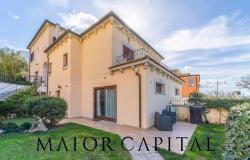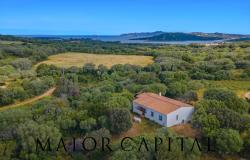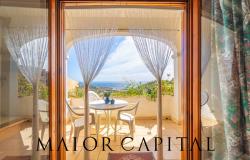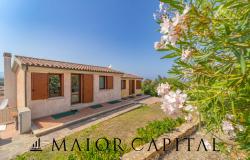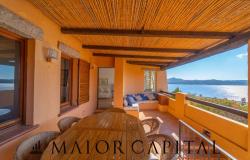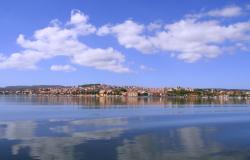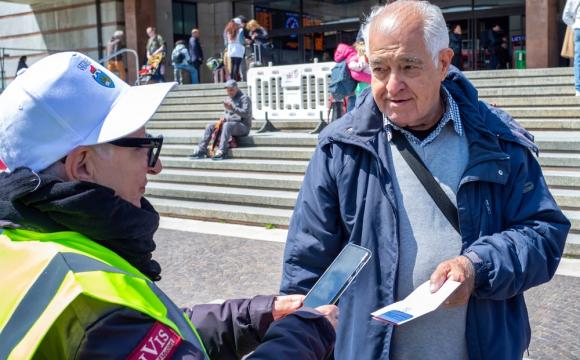Beneath an old and twisted olive tree, a group of men huddle together in a semi-circle, their heads close together, and start to sing. The sound has a strange tonal quality, something that seems ancient and haunting, yet still pleasing to the modern ear. They are outside the town of Arzachena, next to the Coddu Vecchiu (or ‘Ecchju’), one of the megalithic stone tombs known by the locals as ‘Tombs of the Giants’, not because their ancestors were big, but because the tombs were. In fact, they were communal graves. Like similar structures, this one consists of carved granite stones arranged vertically in a semi-circular formation. The central one is much larger than the others with a small opening into a long stone structure behind.
They are outside the town of Arzachena, next to the Coddu Vecchiu (or ‘Ecchju’), one of the megalithic stone tombs known by the locals as ‘Tombs of the Giants’, not because their ancestors were big, but because the tombs were. In fact, they were communal graves. Like similar structures, this one consists of carved granite stones arranged vertically in a semi-circular formation. The central one is much larger than the others with a small opening into a long stone structure behind.
The tomb lies in a peaceful place, amid olive trees and rock roses. Like many other ‘nuraghic’ sites in the area, it was probably created for the aristocracy about 3500 years ago, just as the Costa Smeralda was created for the rich and famous 40 odd years ago by the Aga Khan. Now, there is a beach resort for every pocket. But the fact remains that, in Sardinia, you can be on the beach one minute and travelling back in time to an ancient civilisation or pastoral world the next.
Beaches, rocks and turquoise blue water
 At Capo Testa in the springtime, you can’t move without crushing tiny wild primulas, camomile, mint or thyme: it’s instant aroma-therapy! Despite being a military zone, a path leads around the lighthouse and across this floral carpet to an area of huge granite boulders, that look inaccessible, but are easy to climb and provide great sunbathing beds, with access to little cooling pools down at sea level. If it is beautiful during the day, it is stunning at sunset and magnificent in a storm, when the wind almost blows your head off and the waves crash over the rocks in a terrible fury.
At Capo Testa in the springtime, you can’t move without crushing tiny wild primulas, camomile, mint or thyme: it’s instant aroma-therapy! Despite being a military zone, a path leads around the lighthouse and across this floral carpet to an area of huge granite boulders, that look inaccessible, but are easy to climb and provide great sunbathing beds, with access to little cooling pools down at sea level. If it is beautiful during the day, it is stunning at sunset and magnificent in a storm, when the wind almost blows your head off and the waves crash over the rocks in a terrible fury.
Capo Testa lies at the very end of the road, on the far north-western tip of Sardinia, where you can choose your holiday destination based on what kind of beach (or rocks) you like. If you favour white sand beaches, rose-coloured granite rocks and rocky islands, with the possibility of a boat trip, then you should head for the protected beaches of the north coast. If you want a beach that goes on forever, with hardly a soul on it; and with great sunset views, then the Costa Paradiso on the north-west coast is good. For somewhere completely ‘away from it all’, with fine white sand and shallow water try the Pelosa beach near Stintino.
In the heart of the Costa Smeralda on the north-eastern coast, Porto Cervo is a white-washed village, full of mega-yachts, expensive boutiques and supermodels. It’s also overcrowded and, from here to Santa Teresa di Galura on the western tip of the island, there is almost continuous resort and villa development. Fine if you want resort services and activities and a busy nightlife.
Even where it’s busy, it is never too far from a beautiful beach. From the north coast, you can also escape from the crowds by taking a boat trip out to the Islands of the Maddalena, some of which are nature reserves. If you want something more low-key, however, you must head either further west, to the Costa Paradiso on the west coast; or further east to the most unspoilt part of the Costa Smeralda. Stay near Capriccioli, for example, with its pretty beach and sense of low-key wealth, and rent a boat for a few hours to go out to the granite islands of Soffior Mortorio. Outside the main season, you may have them entirely to yourself. It’s not surprising that two of the most exclusive hotels (Hotels Romazzino and Cala di Volpe) are in this area, while the local villa owners include the Italian industrialist, De Benedetti.
Stay near Capriccioli, for example, with its pretty beach and sense of low-key wealth, and rent a boat for a few hours to go out to the granite islands of Soffior Mortorio. Outside the main season, you may have them entirely to yourself. It’s not surprising that two of the most exclusive hotels (Hotels Romazzino and Cala di Volpe) are in this area, while the local villa owners include the Italian industrialist, De Benedetti.
If days are spent beaching, bathing, windsurfing and snorkelling, an excursion to Capo d’Orso (or ‘Bear Rock’) is a perfect way of working up an appetite for dinner. Lying at the end of the beach road east of Palau, it takes about 20 minutes to climb to the top, with its wonderful views over the Archipelago of the Maddalena, with Corsica in the distance.
Northern Sardinia is full of granite rocks like Bear Rock, which have been eroded by wind and weather into fantastic shapes. In nearby Arzarchena, there is a mushroom shaped one; while outside Castelsardo, there is a smaller one in the shape of an elephant. If you are interested in a longer hike in amid strange rock formations of great beauty, it is difficult to beat the ‘Valle della Luna’ (Valley of the Moon), outside Aggius.
Aggius - famous for feuds and carpets!
 Aggius is a small granite village in the interior, that is famous for its bandits, its carpets, its choir and its feuds. At the Agriturismo, ‘Il Muto di Gallura’, owned by Gianfranco Serra and Francesca Cannas, Francesca explained the legend of the worst feud in local history: ‘Il Muto di Gallura was a famous bandit, who got involved in a feud in the 19th century between the Mamai and Vasa families. It all started over a beautiful girl and some killed goats, typical vendetta material!
Aggius is a small granite village in the interior, that is famous for its bandits, its carpets, its choir and its feuds. At the Agriturismo, ‘Il Muto di Gallura’, owned by Gianfranco Serra and Francesca Cannas, Francesca explained the legend of the worst feud in local history: ‘Il Muto di Gallura was a famous bandit, who got involved in a feud in the 19th century between the Mamai and Vasa families. It all started over a beautiful girl and some killed goats, typical vendetta material!
By 1856, when the feud ended, it had involved 600 people and lots of blood: brutality, but also romance!’ If you fancy romance Aggius-style, you might want to come here on the first Sunday in October for the Festa di li ‘Agghiani – the Bachelors’ Feast.
In the old days, an embrace meant an engagement, so be careful! Now, most feuds concern which village has the best choir, or who has the best recipe for the suppa gallurese (which contains bread, cheese, broth and spices, baked in a wood oven).
The village of Aggius makes a good base for exploring the cork oak producing areas around Calangius; the ancient dolmens (tombs) at Luras and the Nuraghe Maiori outside Tempio Pausania. Nuraghi provided a combination of dwelling and fortification and the Nuraghe Maiori, a stone tower in a grove of cork oaks, is in a particularly beautiful spot for a picnic. You can also go hiking, rock climbing, or riding and in Aggius itself you can visit local women who still make rugs on hand looms.
Perfect picnic places
 Sardinia is made for country picnics; and the best picnic spot in the whole of Northern Sicily has to be by the 12th-century striped church of San Pietro delle Immagini, just outside Bulzi, east of Castelsardo. With a stone bench and table, fresh water and a great view, it is difficult to beat. There is a whole series of Benedictine churches, which were built in the 12th and 13th centuries mainly by craftsmen from Pisa, to help form a bulwark against Arab invasion.
Sardinia is made for country picnics; and the best picnic spot in the whole of Northern Sicily has to be by the 12th-century striped church of San Pietro delle Immagini, just outside Bulzi, east of Castelsardo. With a stone bench and table, fresh water and a great view, it is difficult to beat. There is a whole series of Benedictine churches, which were built in the 12th and 13th centuries mainly by craftsmen from Pisa, to help form a bulwark against Arab invasion. Another small one is in the village at Tergu (built over a Roman temple); while the grandest of them all is the Basilica della Santissima Trinita di Saccargia, whose bell tower stands out in the fields of wheat east of Sassari. The simple elegance of its black and white Romanesque structure contrasts with the intricacy of the carved stone capitals in the loggia and the delicacy of the frescoes that cover the apse.
Another small one is in the village at Tergu (built over a Roman temple); while the grandest of them all is the Basilica della Santissima Trinita di Saccargia, whose bell tower stands out in the fields of wheat east of Sassari. The simple elegance of its black and white Romanesque structure contrasts with the intricacy of the carved stone capitals in the loggia and the delicacy of the frescoes that cover the apse.
If you get this far, you may as well look at Sassari, the sprawling provincial capital, which has a few interesting buildings and a good museum (but is otherwise unattractive). The best time to come is for the Cavalcata, a festival on the penultimate Sunday in May. It features music, dancing, equestrian displays and a long procession of groups of people from all over Sardinia, dressed in traditional costume.
Castelsardo: shopping and touring
 Sassari, Bulzi and Tergu are all easily accessible on day trips from Castelsardo, a fortress town built by the Genoese in the 12th century on a rocky promontory on the west cost. Conquered by the Aragonese in the 15th century, it is one of the more attractive towns in Northern Sardinia, with a wide choice of beaches within 30 minutes’ drive.
Sassari, Bulzi and Tergu are all easily accessible on day trips from Castelsardo, a fortress town built by the Genoese in the 12th century on a rocky promontory on the west cost. Conquered by the Aragonese in the 15th century, it is one of the more attractive towns in Northern Sardinia, with a wide choice of beaches within 30 minutes’ drive.
If fishermen down in the harbour are mending their nets, up in the narrow lanes of the old town at the top of the hill, it seems that every house- wife is busy on her doorstep making a basket. Traditionally made of palm leaves and asphodel, whose white flowers cover the fields in the spring, the designs are varied and colourful, the workmanship, superb.
There is even a museum of basketry. The best time to come here is Easter, when the candlelit Holy Week processions of hooded penitents create an eerie and haunting atmosphere. Castelsardo is a great place to eat seafood, either at Il Cormorano, in the old town, or down the road at Da Ugo in Lu Bagnu. Meanwhile, the shops have plenty of Sardinian specialities. Apart from baskets, you can find ceramics and even hand-made pipes and carpets, while food lovers might prefer to look for local wines, pecorino cheese and cakes. It is a good place to end your stay.

